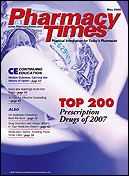Black Box Warnings Incite Red Flags
The FDA directs that all SSRIs contain a black box warning. Patients taking these medications may continue therapy, but they should be monitored carefully on a regular basis.
Dr. Kyle is an assistant professor ofpharmacy practice at the GregorySchool of Pharmacy at Palm BeachAtlantic University,West Palm Beach,Florida. Ms. Cortes is a 2009 PharmDcandidate at the Gregory School ofPharmacy at Palm Beach AtlanticUniversity,West Palm Beach, Florida.

What is a black box warning? Ablack box warning, commonlyreferred to as a boxedwarning, is a notification to practitionersfrom the FDA that 1 of 3 situations hasoccurred: (1) "There is an adverse reactionso serious in proportion to thepotential benefit from the drug that it isessential that it be considered in assessingthe risks and benefits of using adrug"; (2) "There is a serious adverseevent reaction that can be prevented orreduced in frequency or severity byappropriate use of the drug"; or (3) "FDAapproved the drug with restrictions toassure safe use because FDA concludedthat the drug can be safely used only ifdistribution or use is restricted."1
Does this mean that a drug with ablack box warning should not be used?No, it does not. The FDA requires thewarning to be placed in the packageinsert so that practitioners can heed thewarnings. Medications with a black boxwarning have either shown or areexpected to have a serious adverseevent or death. Therefore, patients whoare on these medications should becarefully monitored on a regular basis.
Based on a number of both publishedand unpublished trials, the FDA voted 18to 5 on September 14, 2004, to issue ablack box warning for all selective serotoninreuptake inhibitors (SSRIs) stating:"Antidepressants increased the risk ofsuicidal thinking and behavior (suicidality)in short-term studies in childrenand adolescentswith manic depressive disorder (MDD) andother psychiatric disorders."2 Additionally,it was observed that the increased risk of suicide was higherduring the first few months of treatment withan SSRI.3 The initial concern overthe increased risk of suicide inchildren stemmed from reports of suicidal behavioroccurring in some paroxetine (Paxil) trials,as well as recommendations fromthe United Kingdom Medicines andHealthcare Products Regulatory Agencyurging that paroxetine not be used inindividuals younger than 18 years old.4
The FDA then began an investigationreviewing some 23 trials funded byindustry, as well as the Treatment forAdolescents with Depression Study(TADS). The analysis from these 24 trials,which included approximately 4000patients, overall found that suicidalbehavior occurred in 109 patients; inaddition, 47 patients were hospitalizedand 66 committed harm to themselves,but an actual incidence of suicide wasnever reported.5
Some of the data collected by the FDAfrom the 23 unpublished industry-fundedtrials included the following medications:fluoxetine (Prozac), sertraline (Zoloft),paroxetine, citalopram (Celexa), and venlafaxine(Effexor). Fluoxetine did not showa "suicide/self-harm risk" in 2 trials thatwere analyzed.5 Another with sertralinehad a 4.1% "possibly suicide-related" riskversus 0% in placebo.5 A paroxetine trialrevealed a "possibly suicide-related" risk of6.5% versus 1.1% in placebo; in addition,the trial found 5.4% suicide attempts versus0% in placebo.5 One citalopram studyshowed a 13% "possibly suicide-related"risk and suicide attempts versus 8% inplacebo.5 Venlafaxine is not considered anSSRI, but it also revealed an increase in"possibly suicide-related" risk and suicideattempts, when compared with placebo.5
Although FDA officials knew of thesefindings, they contracted experts fromColumbia University to review the narrativesof adverse events reports and toreport the incidence of suicidality from theindustry-funded unpublished trials.6 TheFDA researchers then compiled all theinformation into a meta-analysis, and theresults revealed that suicide behavior inchildren was 2 times greater than withplacebo.6
The TADS study was a 12-week randomized,placebo-controlled trial thatincluded 439 patients aged 12 to 17years old with an MDD diagnosis.7 Theparticipants were randomized to one of4 treatment arms: cognitive-behavioraltherapy (CBT) alone, fluoxetine alone(FLX), combination of fluoxetine withCBT, or placebo.7 The study authors concludedthat the combination therapy(fluoxetine with CBT) had greater effectivenessin reducing the symptoms ofdepression.7 In the December 2006TADS study, safety results were published,and the authors compared the"rates of physical, psychiatric, and suicide-related events in adolescents withMDD treated with [FLX], CBT, combinationtreatment, or placebo."8 Althoughthe article reported 24 suicide-relatedevents, only 23 cases were documented:5 in the CBT arm, 10 in the fluoxetinearm, 5 in the combination arm, and 3with placebo.8
The authors revealed that only 5 actualsuicide attempts occurred: 1 in theCBT arm, 2 in the fluoxetine arm, 2 in thecombination arm, and 0 in the placeboarm.8 The study concluded that a combinationof fluoxetine and CBT is saferthan using a medication alone, because,although suicidal ideation improved inall treatment arms, the greatest improvementwas seen in the combinationtreatment arm.8
In trying to assess the risk of suicidalthoughts and behavior in adults, the FDAcollected data from 295 trials thatincluded approximately 77,000 patientswith MDD and other psychiatric disorders.9 Then in December 2006, after theinformation was compiled and interpreted,the FDA?s PsychopharmacologicDrugs Advisory Committee agreed thatlabeling changes should be made inorder to increase awareness of the riskof suicide in young adults.9 The committeealso stated that practitioners shouldbe reminded that the use of antidepressantsis beneficial in older adults andthat underlying psychiatric disordersalso can cause an increase in suicidality.
On May 2, 2007, the FDA proposedthat all manufacturers update and add astatement of an increased risk of suicidalbehavior for individuals aged 18through 24 years to the black box warningon all antidepressant medications?labeling.9 In addition to the inclusion of ablack box warning to the labeling, theFDA recommended that cliniciansassess the risk of suicide prior to prescribingan antidepressant in childrenand adolescents.
At the time an antidepressant is dispensed,the FDA requires that a medicationguide be given to each patient. Themedication guide includes symptomsthat the patient?s family/caregiver shouldwatch for, major counseling points concerningantidepressant medications, andthe most important information regardingantidepressants and suicidal behavior.During this time, pharmacists shouldtake the opportunity to review the medicationguide with the patient and/orcaregiver. Pharmacists also shouldencourage families to be very observantof their children?s behavior or any unusualchange in behavior that may lend itselfto suicide, especially during the initial fewmonths of a course of drug therapy, or attimes of dose changes. Symptoms suchas anxiety, agitation, panic attacks, irritability,hostility, impulsivity, and maniamay represent warning signs of suicidalideation. Patients should be aware ofalternative forms of treatment such asCBT. CBT is a "relatively short-term focusedpsychotherapy for a wide range of psychologicalproblems."10 In children andadolescents, CBT often is used to treatdepression, anxiety, obsessive?compulsivedisorder, and attention-deficit/hyperactivitydisorder, with the ultimate goal ofimproving one?s quality of life.11
Currently, the only FDA-approvedSSRIs for use in pediatrics include fluoxetinefor MDD and sertraline, fluoxetine,paroxetine, and fluvoxamine (Luvox) forobsessive?compulsive disorder.12-15 Despitethe fact that SSRIs have a black boxwarning of suicidality for use in childrenand adolescents, these medicationshave been proven safe and effective andare still frequently prescribed. Patientswith a prior history of suicidal ideation orbehavior, however, should have considerationof other options such as CBTbefore an SSRI is initiated.
References
- FDA/CBER resources page. Food and Drug Administration Web site. Available at: www.fda.gov/cber/gdlns/boxwarlb.htm. Accessed January 23, 2008.
- Black Box Warnings from Drug Facts & Comparisons page. Facts & Comparisons Web site. Available at: online.factsandcomparisons.com. Accessed January 23, 2008.
- Revisions to Product Labeling. FDA Web site. Available at: www.fda.gov/cder/drug/antidepressants/antidepressants_label_change_2007.pdf. Accessed January 23, 2008.
- Leslie LK, Newman TB, Chesney PM, Perrin JM. The Food and Drug Administration's deliberation on antidepressant use in pediatric patients. Pediatrics. 2005;116:195-204.
- FDA Antidepressant Suicide Warning. McMan's Depression and Bipolar Web site. Available at: www.mcmanweb.com/FDA_suicide.htm. Accessed January 29, 2008.
- Newman TB. A black box warning for antidepressants in children? N Engl J Med. 2004;351:1595-8.
- March J, Silva S, Petrycki S, et al. Fluoxetine, a cognitive-behavioral therapy, and their combination for adolescents with depression: Treatment for Adolescents with depression study (TADS) randomized controlled trial. JAMA. 2004;292:807-20.
- Emslie G, Kratochvil C, Vitiello B, et al. Treatment for Adolescents with Depression Study (TADS): safety results. J Am Acad Child Adolesc Psychiatry. 2006;45:1440-55.
- FDA News page. Food and Drug Administration Web site. Available at: www.fda.gov/bbs/topics/news/2007/new01624.html. Accessed February 24, 2008.
- What is cognitive therapy?. The American Institute for Cognitive Therapy Web site. Available at: www.cognitivetherapynyc.com/default.asp?sid=768. Accessed February 9, 2008.
- Child and Adolescent Treatment page. The American Institute for Cognitive Therapy Web site. Available at: www.cognitivetherapynyc.com/child.asp. Accessed February 9, 2008.
- Prozac [package insert]. Indianapolis, IN: Eli Lilly and Co; 2008.
- Zoloft [package insert]. New York, NY: Roerig, a division of Pfizer, Inc., 2008.
- Paxil [package insert]. Research Triangle Park, NC: GlaxoSmithKline, 2008.
- Luvox [package insert]. Marietta, GA: Solvay Pharmaceuticals, Inc. 2000.

